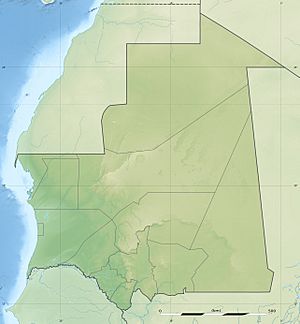Azougui facts for kids
Quick facts for kids
Azougui
آزوكي
Azuggi
|
|
|---|---|
|
Site of medieval town
|
|

Archaeological site
|
|
| Country | |
| Region | Adrar Region |
Azougui (also called Azuggi) was an important ancient town in northwestern Mauritania. It was located on the Adrar Plateau, a high, flat area of land. Azougui was especially famous in the 11th century. At that time, it became the very first capital city of the powerful Almoravid dynasty. This empire grew to control a huge area. It stretched from the Ghana Empire in the south to Morocco and even parts of the Iberian Peninsula (modern-day Spain and Portugal).
Contents
Azougui: An Ancient Capital
Azougui was a key city for the Almoravids. These were Berber tribes from the desert, mainly the Lamtuna and Gudala. A writer named al-Bakri (who lived around 1040–1094) wrote about Azougui. He said a strong fortress was built there. This fortress was surrounded by 20,000 palm trees. It was built by Yannu ibn Umar, a brother of the first Almoravid leaders. The fortress marked the border between the lands of the Lamtuna and Gudala tribes.
The Rise of the Almoravids
The Lamtuna tribe formed the main part of the Almoravid army. However, the Gudala tribe later broke away from them. Near Azougui, at a place called Tabfarilla, the Almoravids faced a big defeat. In 1056, the Gudala tribe crushed an Almoravid army from Azougui. Their leader, Yahya ibn Umar, was killed. Even with this defeat, Azougui and the nearby battlefield became very important to the Almoravids. Both al-Bakri and another writer, al-Zuhri, called Azougui the capital of the Almoravid empire.
A Hub for Trade
Azougui was also a vital stop on the trans-Saharan trade route. This was a long journey across the Sahara Desert. Goods were traded between Morocco and the Ghana Empire. Another famous writer, Al-Idrisi, said that anyone traveling to the countries of Sila, Takrur, and Ghana had to pass through Azougui. He also noted that the people from the Guinea region, likely the Soninke, called the town "Quqadam." This shows how well-known and important Azougui was for trade.
Old History and Remains
The history of Azougui goes back even further than the Almoravids. There are rock carvings found at the site from the seventh century. This means people lived and created art there long ago. Today, you can still see parts of the old citadel (a strong fortress) and the necropolis (a large ancient cemetery) of al-Imam al-Hadrami. These ruins give us clues about what life was like in this ancient city.
World Heritage Status
Because of its rich history and important ruins, Azougui has been recognized internationally. On June 14, 2001, this site was added to the UNESCO World Heritage Tentative List. This means it is being considered for official World Heritage status. It is listed in the Cultural category, showing its importance to human history and culture.
See also
 In Spanish: Azugui para niños
In Spanish: Azugui para niños


